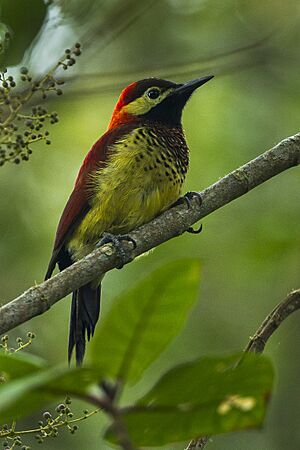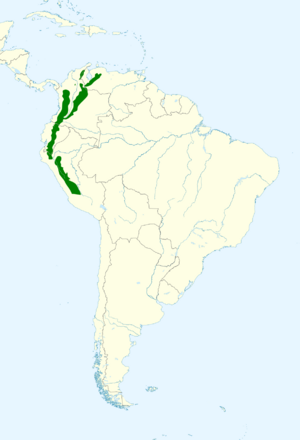Crimson-mantled woodpecker facts for kids
The crimson-mantled woodpecker (Colaptes rivolii) is a beautiful bird. It is part of the woodpecker family. You can find it in several South American countries. These include Bolivia, Colombia, Ecuador, Peru, and Venezuela. This bird is known for its bright red feathers.
Quick facts for kids Crimson-mantled woodpecker |
|
|---|---|
 |
|
| Conservation status | |
| Scientific classification | |
| Genus: |
Colaptes
|
| Species: |
rivolii
|
 |
|
| Range of crimson-mantled woodpecker sensu stricto | |
| Synonyms | |
|
|
Contents
How Scientists Classify This Woodpecker
Scientists first named this woodpecker Picus Rivolii. Over time, they learned more about birds. So, they changed its scientific name a few times. Since about 2007, it has been placed in the Colaptes group. This is where most experts agree it belongs today.
Different Types of Crimson-Mantled Woodpeckers
There are six main types, or subspecies, of the crimson-mantled woodpecker. They are all slightly different.
- C. r. quindiuna
- C. r. zuliensis
- C. r. rivolii
- C. r. meridae
- C. r. brevirostris
- C. r. atriceps
One group, BirdLife International, thinks C. r. atriceps is a separate species. They call it the black-crowned woodpecker. But most other bird experts see it as a subspecies.
The name rivolii honors a French bird expert. His name was François Victor Masséna.
What Does the Crimson-Mantled Woodpecker Look Like?
This woodpecker is about 23 to 26 centimeters (9 to 10 inches) long. It weighs between 85 and 112 grams (3 to 4 ounces). That's about as much as a small apple!
Males and females look very similar. The main differences are on their heads.
Male and Female Colors
- Males usually have a bright red cap on their head. Their face is pale yellow. They have a dark red stripe near their cheek. Their chin and throat are black.
- Females have a black cap on their head. They also have a black stripe near their cheek.
Both males and females have a bright crimson red neck and back. Their lower back and tail feathers are black. Their wings are a shiny bronze-red color. Their tail is black. Their belly is yellow. It has black and red patterns on the chest. Sometimes there are black spots on the belly.
Their beak is black. Their eyes are reddish-brown or brown. Their legs are light gray.
Young Woodpeckers
Young woodpeckers are not as brightly colored as adults. They do not have red on their chest. Young males have a blacker cap than adult males.
Differences in Subspecies
Most subspecies look very much like the main type (C. r. rivolii). But C. r. atriceps is a bit different. Males of this type have a larger black cap. Both males and females of atriceps do not have red on their chest. Their wings are also less red than the main type.
Where Does This Woodpecker Live?
The crimson-mantled woodpecker lives in the Andes mountains. These mountains stretch across South America.
Specific Locations for Each Type
- C. r. quindiuna lives in central Colombia.
- C. r. zuliensis is found on the border of Colombia and Venezuela.
- C. r. rivolii lives in eastern Colombia and northwestern Venezuela.
- C. r. meridae is in the Andes of northwestern Venezuela.
- C. r. brevirostris lives from southwestern Colombia, through Ecuador, to central Peru.
- C. r. atriceps is found in southeastern Peru and western and central Bolivia.
Its Home in the Mountains
This woodpecker likes to live inside and at the edges of wet mountain forests. It also lives at the lower parts of the páramo zone. The páramo is a special type of high-altitude grassland. In Ecuador, you can usually find them at elevations between 2,000 and 3,300 meters (6,600 to 10,800 feet) high.
How Does the Crimson-Mantled Woodpecker Behave?
What It Eats
The crimson-mantled woodpecker looks for food all over the forest. It often searches on branches covered in moss and lichen. It also looks on tree trunks. Its main food is small insects, especially ants. It also eats fruit.
It usually hunts alone or in pairs. But it often joins groups of different bird species. They all look for food together. This woodpecker avoids a thorny bush called gorse.
Raising a Family
Scientists don't know much about when this woodpecker breeds. It seems to be different depending on where they live. Some think it might be from June to November in Peru. Others suggest February to March for the whole species.
They build their nests inside tree holes. But not much else is known about how they raise their young.
Sounds It Makes
The most common type of crimson-mantled woodpecker makes a song. It sounds like a fast, metallic "kee'r'r-ker'r-ke'r'r". The atriceps type has a different song. It sounds like a low, descending "grr'r'r'r'l". This bird also makes a rising "REE?" call.
Like other woodpeckers, it drums on trees. But it doesn't do it very often.
Is the Crimson-Mantled Woodpecker in Danger?
Good news! The crimson-mantled woodpecker is listed as "Least Concern." This means it is not currently in danger of disappearing. This is true for both the main species and the black-crowned woodpecker type.
Scientists don't know exactly how many of these birds there are. But they believe their numbers are stable. No big threats have been found for them right now. The biggest problem they face is when humans destroy their forest homes.


